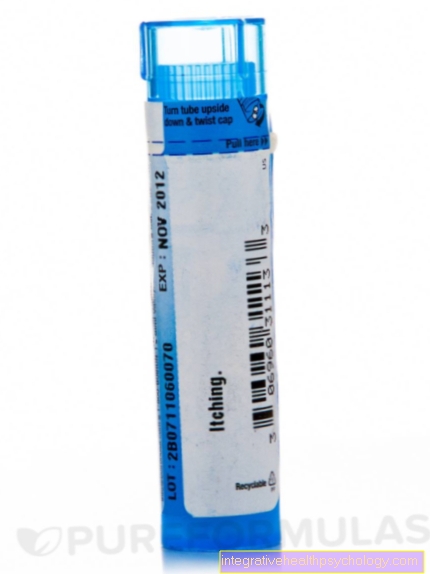Blood pressure - how do I measure correctly?
introduction
With the help of technical processes, the pressure in a blood vessel is determined when measuring blood pressure. A distinction is made between the measurement of arterial and venous pressure.
Since the measurement of arterial pressure is a very simple method, it plays a very important role in everyday medical practice. Various methods can be used to measure pressure.

How is blood pressure measured?
Blood pressure provides us with important information about the pressure in the blood vessels and about the function of the cardiovascular system.
When measuring blood pressure, a general distinction is made between systolic and diastolic blood pressure.
The systolic value is always the higher of the two values. When the heart contracts and pumps blood to the body, the systolic value is determined.
During the diastolic reading, the heart relaxes and refills with blood.
The blood pressure should be measured at rest. To measure blood pressure, an inflatable cuff is usually attached to the upper arm, approximately at heart level.
Depending on the patient's arm circumference, the cuff must be neither too narrow nor too wide. Cuffs that are too wide measure values that are too small and cuffs that are too narrow measure values that are too high.
The blood pressure can be determined on both the left and the right arm, or it should ideally be checked on both sides in order to rule out a side difference that can indicate vascular occlusion.
It is best to measure blood pressure in the morning and before taking antihypertensive medication, as it is often too high in the morning.
The method of indirect blood pressure measurement using a blood pressure cuff was developed by the physician Riva-Rocchi and therefore bears the initials RR.
By inflating the cuff, the humerus artery is completely squeezed so that no more blood can flow through it. The pressure should be built up so that the values are safely above the expected systolic blood pressure.
Then the pressure is released from the cuff. At the same time, the examiner uses a stethoscope to listen to the artery in the crook of the elbow.
From the systolic pressure, blood can flow through the vessel again.
Since the vessel is not yet fully open again, it flows turbulently and generates the so-called Korotkow sounds, which can be heard on the artery with a stethoscope. The sounds then stop when diastolic pressure is reached. At the time of the diastolic pressure, the vessel is completely open again and the blood can flow evenly through the artery again without generating Korotkow sounds.
In order to obtain a statement about the course of the day's blood pressure, a 24-hour measurement can be ordered by the doctor, during which every 15 to 30 minutes the blood pressure is measured.
There are also digital devices available for patients to measure themselves, which make it much easier to measure blood pressure. Most patients have digital devices that are also placed on the upper arm. Attention should also be paid to attaching the cuff at heart level and measurements should be taken while sitting or lying down. In contrast to the manual measuring method, with digital measuring devices the blood pressure values are displayed directly on the device. Inflation is also automatic.
There are also invasive or direct methods for measuring blood pressure, in which a pressure sensor is inserted directly into a vessel. This allows the blood pressure to be monitored more precisely and continuously, which is particularly useful in intensive care medicine.
Measuring blood pressure on the upper arm or wrist - which is better?
Generally there are blood pressure monitors that measure either on the wrist or on the upper arm. If the device is set correctly and is used absolutely as specified, it makes no difference where you measure your blood pressure. However, in reality this is rarely the case and errors in measurements on the wrist are much more common.
This is mainly due to the fact that the cuff should be at heart level throughout the measurement process. This is easy to do with the upper arm by sitting quietly and simply letting your arm hang down. However, when measuring on the wrist, the arm must be held at the correct angle. This is often wrongly chosen and not adhered to the entire time of the measurement. This measurement error can then vary so much from day to day that the values can no longer be compared and the blood pressure measurement is carried out for free.
The only mistake that can occur when measuring on the upper arm are blood pressure values measured too high due to a cuff that is too narrow in thick people. When buying a blood pressure monitor, it is best to use an upper arm monitor and get advice on the cuff size and width beforehand.
Which arm should I take?
The question of which arm to measure on differs from person to person and depends on where the blood pressure was higher when it was first measured. So if you start over to measure your blood pressure regularly with the help of a home device or switch to another device, you should measure on both arms the first time you use it.
If the blood pressure is higher on the left arm than on the right, it should always be measured on the left arm in the future. If it is higher on the right, then on the right. Of course, measurements can also be made on both arms every time, but this takes significantly more time, which is why it is not particularly suitable for everyday use.
Is there a difference between lying down and sitting down?
When you are standing or sitting, your blood vessels need to be tight to some degree in order for the blood to move from your legs back to your heart. If they weren't tense, the blood would "sink" in the legs and one would be very dizzy on a regular basis. When you lie down, your legs and heart are on the same level, which relaxes the muscles around the blood vessels.
In addition, the rest of the body as a whole relaxes due to the fact that we are lying down and about to sleep or at least to rest. This lowers blood pressure. If we sit up again, the blood pressure rises again together with the pulse to ensure adequate blood flow. So it can be said that the difference between a lying down and a sitting blood pressure measurement is that the blood pressure will be lower when lying down than when sitting down. However, this difference is usually not very large.
It is more important to always measure the blood pressure in the same position, i.e. always lying down or sitting. This enables the measured blood pressure values to be better compared with one another and changes to be recognized.
Do I always have to measure my blood pressure at the same time?
It makes sense to always measure the blood pressure at the same time or always to measure it in the morning or in the evening. Once a point in time has been determined at which to measure, this should be adhered to in the future.
The reason for this is our fluctuating hormone balance, which can have a significant impact on blood pressure. In the morning, the body secretes more of the hormone cortisone, which makes us awake and active. This increases blood pressure. In the evening, however, when it gets dark, the hormone melatonin is increasingly produced. It makes us tired and ensures that all body functions are shut down. So does the blood pressure. Therefore, blood pressure values measured in the morning and evening can hardly be compared.
How often should i measure my blood pressure?
In the initial phase after the diagnosis of "high blood pressure" has started, measurements should be made in the morning and evening if possible. Because of our hormones, blood pressure is subject to natural fluctuations throughout the day. The morning and evening measurements make it possible to check whether these fluctuations are actually taking place or whether there are possibly disturbances that can cause a generally high blood pressure.
After this initial phase, in which the correct dose for any medication has to be found, it is sufficient to measure once a day, always at the same time of day.
Do thick upper arms affect the blood pressure measurement?
Thick upper arms only influence the blood pressure measurement if the cuff of the blood pressure monitor is too tight and too narrow. In this case, it comes to false high blood pressure values.
If, on the other hand, the circumference of the upper arm is measured when the device is purchased and a measuring device with a larger cuff is selected, the thickness of the upper arm no longer has any influence on the measurement result.
Blood pressure values - what do you say?
The blood pressure (blood pressure value) is expressed in the unit of measurement mmHg (Millimeters of mercury) measured.
The upper of the two values corresponds to the systolic pressure, the pressure that builds up when the heart pumps its blood into the body.
The lower value, the diastolic value, arises during the relaxation / filling phase of the heart.
The optimal blood pressure is 120/80 mmHg. From high blood pressure (hypertension) one speaks from values of 140/90 mmHg.
High blood pressure can be divided into three stages:
- in stage I the blood pressure is between 140/90 and 160/100,
- in stage II between 160/90 and 180/100 and
- in stage III over 180/110.
In order to diagnose an actual high blood pressure, the blood pressure measurements have to be carried out several times at different times and days.
Depending on the severity of the hypertension, the blood pressure must be treated differently with medication.
Blood pressure that is too low (Hypotension) applies to values below 100/60 mmHg.
With values above 230/130 mmHg one speaks of either a hypertensive crisis or a hypertensive emergency.
In contrast to a hypertensive emergency, there is no organ damage in a hypertensive crisis.
In both cases, immediate action must be taken and blood pressure lowered.
Older patients often experience what is known as isolated systolic hypertension. This means that only the systolic value is increased, while the diastolic value is at normal values.
For example, an isolated systolic hypertension is a blood pressure of 190/80 mmHg.
Often the blood pressure is falsely increased during doctor measurements due to excitement, this is known as white coat hypertension.
Read more on the subject:
- Blood pressure values - which are normal, which are not?
- Low Blood Pressure And Nausea - You Can Do That!
I measure different values on the arms, what does that mean?
Different values measured on both arms are initially not a cause for concern, because there are many factors that have an influence on the measurement. Therefore, you will probably never even measure the exact same value on both arms. It is said that a difference of up to 20 mmHg is normal. Usually this is caused by varying degrees of tension in the muscles, because even if we think we are completely relaxed, this is usually not the case. In addition, the circumference of our arms is never exactly the same, although this also has an influence on the measurement.
However, if the values differ by more than 20 mmHg, diseases such as peripheral arterial occlusive disease, also called PAOD, or the so-called subclavian steel syndrome can be the cause. In such cases, you should therefore consult your family doctor.
What is long-term blood pressure measurement?
With a long-term blood pressure measurement, the blood pressure is measured regularly and automatically over a period of usually 24 hours. As a rule, it is an upper arm measuring device, i.e. the cuff is placed around the upper arm and the actual measuring device is carried in a small bag. The blood pressure is then measured approximately every 15 to 30 minutes during the day, and the interval between the individual measurements is usually longer at night.
In addition, the wearer of the device is required to write a log of the 24 hours in which he notes all his activities and psychological experiences. As a result, when evaluating the long-term measurement, the doctor can better assess which factors had an influence on the patient's blood pressure. He can also observe the fluctuations in blood pressure throughout the day and assess whether these correspond to the natural fluctuations caused by hormones. Blood pressure should drop significantly at night, rise towards morning and be in a medium range during the day.
The device is put on the patient by a doctor in the morning, test measurements are carried out and then the wearer can go about his normal everyday life. The next morning, the device is removed again in the same practice and evaluated by the doctor. This is usually followed by a discussion of the results.
Read more on the subject: Long-term blood pressure measurement
Can you measure blood pressure without a device?
It is not yet possible to measure blood pressure without special aids.
The only circulatory parameter that can be measured without a device is the pulse, for which only a watch with a second hand is required.
To measure your pulse, you have to find it first. This works best on the wrist or neck. Usually you put the index and middle finger on the spot where the pulse can be felt and count the number of pulse beats for 60 seconds.
It is not recommended to count the pulse beats for a shorter time and then to multiply their number, as in individual cases the heart can also beat irregularly (arrhythmia) and the calculated pulse rate would therefore be inaccurate.
Since the heart rate can be influenced by many different factors, such as physical activity, psychological tension or body position, it is best to measure the pulse while lying down and at rest. After strenuous physical activity, wait a few minutes for the heart rate to stabilize before measuring the heart rate. The resting heart rate of an adult is 60 to 80 beats per minute.
Can the measurement also be carried out with a mobile phone or an app?
Actually measuring blood pressure is still not possible with an app or a mobile phone.
Some apps state that they can measure blood pressure using the mobile phone camera, but this is an estimation method that only provides very imprecise values and should therefore not be used for proper blood pressure measurement.
It is therefore advisable to continue to use a classic blood pressure monitor to measure blood pressure. However, there are now apps in which you can enter the daily blood pressure values. So they have a kind of diary function and help to keep an overview and to recognize changes at an early stage. Most of them also create diagrams from the values entered so that you can visualize and clearly display your values. Such functions may seem trivial at first, but various studies have already shown that blood pressure apps help patients better understand and control their own disease, high blood pressure, and thus lead a healthier life.
Some apps also provide tips and advice on diet and exercise and help plan and monitor daily medication intake. Thus, they can support the user in all areas and facilitate the handling of the disease in everyday life.
Can you measure blood pressure while exercising?
It is not possible to measure blood pressure in a meaningful and precise manner while exercising, as there are no suitable devices available. Only the pulse, the heart rate, can be measured during training using pulse belts that you tighten around your chest. However, if you want to know how exercise changes your own blood pressure, it is sufficient to measure your blood pressure directly before and after exercise using standard measuring devices at home.
This gives you an idea of how the blood pressure changes in the short term. If you write down these values over a longer period of time, you can also record how it changes in the long term through exercising.
Method of measuring blood pressure
Indirect blood pressure measurement
Indirect arterial blood pressure measurement ("NIBP", non-invasive bloog pressure) is a procedure that is used daily in everyday medical practice. A blood pressure cuff is placed on an extremity, usually on the arm, and the blood pressure is then measured using a monitor or stethoscope. Although the measurement in this way is not as accurate as the direct method, the method is safe, faster and does not involve any risks.
In the case of indirect measurement, a distinction is made between manual and automatic blood pressure measurement. The manual blood pressure measurement can be performed with auscultation, palpation and oscillation. In the auscultatory method, the blood pressure cuff is placed around the upper arm and inflated by hand. Then a stethoscope is placed on the crook of the elbow and the pressure in the cuff is slowly reduced again. As soon as the arterial pressure in the vessel exceeds the pressure of the cuff, an auscultatory noise can be heard. This is known as the Korotkow sound and represents the value of the systolic pressure. The pressure in the cuff is further released until the cuff pressure falls below the pressure in the vascular system. At this moment the flow noise stops, this value corresponds to the diastolic blood pressure.
With the palpatory method, too, a blood pressure cuff is placed on the upper arm. The systolic pressure can be determined by releasing the pressure and simultaneously feeling the radial pulse on the wrist. This occurs when, in turn, the pressure in the vascular system exceeds the pressure of the cuff and the pulse can be felt on the wrist for the first time. The diastolic value cannot be determined in this way. For this reason, the palpatory method is the means of choice for orienting measurements in noisy surroundings, for example in the rescue service.
Measuring the oscillatory blood pressure is carried out in the same way as the other two measuring methods, but the blood pressure values are estimated using a pulse-synchronous pointer deflection on the measuring device. The manual method of this procedure is very imprecise. However, blood pressure machines, for example in the recovery room, also measure the pressure using this method. As an alternative to the invasive method, the pressure is measured continuously at intervals of a few minutes. Long-term blood pressure measurement is carried out using the same principle. The patient wears a blood pressure cuff for 24 hours, which inflates itself at certain intervals, automatically measures the blood pressure and saves the values in a recording device. In this way, the blood pressure can be evaluated a whole day later and any high blood pressure detected and assessed.
In all of these procedures, it is a prerequisite that the measurement takes place at heart level. This must be taken into account in particular with measuring devices on the wrist. In addition, the blood pressure cuff must be the right size for the upper arm, otherwise wrongly high or wrongly low values can be measured.
Direct blood pressure measurement
Direct blood pressure measurement ("IBP", "invasive blood pressure") is an invasive method for measuring arterial pressure. A peripheral artery, usually the radial or femoral artery, is punctured from the outside. A small catheter equipped with a pressure sensor is then advanced into the artery. The arterial blood pressure curve is registered via this and displayed on a monitor. The advantage of this method is a continuous monitoring of the blood pressure, as well as a simultaneous measurement of the heart rate and the mean arterial pressure.
Because the method is invasive, there is a risk of bleeding, infection, and nerve damage. For this reason, measuring blood pressure directly is not a routine procedure, but is mainly carried out by anesthetists in an intensive care unit or during operations. Indications for this invasive method are vitally endangered patients as well as major surgical interventions on the heart, vascular system, liver, brain or thorax. As in the arterial system, blood pressure can also be measured directly in the venous system. The superior vena cava (Superior vena cava) punctured and measured the central venous pressure there. Since a right heart catheter examination is carried out as part of this measurement, the pressure in the pulmonary circulation and other areas of the right heart can then be measured at the same time.





























